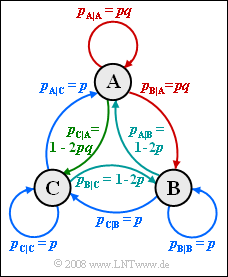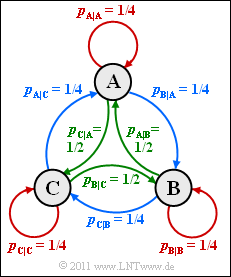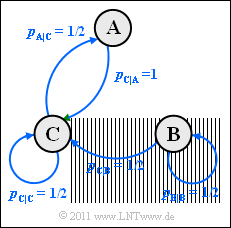Difference between revisions of "Aufgaben:Exercise 1.6Z: Ternary Markov Source"
| Line 22: | Line 22: | ||
*Bei allen Entropien ist die Pseudoeinheit „bit/Symbol” hinzuzufügen. | *Bei allen Entropien ist die Pseudoeinheit „bit/Symbol” hinzuzufügen. | ||
*Sollte die Eingabe des Zahlenwertes „0” erforderlich sein, so geben Sie bitte „0.” ein. | *Sollte die Eingabe des Zahlenwertes „0” erforderlich sein, so geben Sie bitte „0.” ein. | ||
| − | |||
| − | |||
| Line 61: | Line 59: | ||
===Musterlösung=== | ===Musterlösung=== | ||
{{ML-Kopf}} | {{ML-Kopf}} | ||
| − | + | <i>Hinweis:</i> Aus Platzgründen verwenden wir in der Musterlösung „ld” anstelle von „log<sub>2</sub>”. | |
| − | |||
| − | |||
| − | |||
| − | |||
| − | |||
| − | |||
| − | :* | + | '''(1)''' Die maximale Entropie ergibt sich dann, wenn die Symbole $\rm A$, $\rm B$ und $\rm C$ gleichwahrscheinlich und die Symbole innerhalb der Folge statistisch voneinander unabhängig sind. Dann muss gelten: |
| + | * $p_{\rm A} = p_{\rm A|A} = p_{\rm A|B} = p_{\rm A|C} = 1/3$, | ||
| + | * $p_{\rm B} = p_{\rm B|A} = p_{\rm B|B} = p_{\rm B|C} = 1/3$, | ||
| + | * $p_{\rm C} = p_{\rm C|A} = p_{\rm C|B} = p_{\rm C|C} = 1/3$. | ||
| − | |||
| − | |||
| − | : | + | Daraus lassen sich die gesuchten Werte bestimmen: |
| + | *Beispielsweise erhält man aus $p_{\rm C|C} = 1/3$ der Wert $p \hspace{0.15cm}\underline{= 1/3}$. | ||
| + | *Berücksichtigt man noch die Beziehung $p_{\rm A|A} = p \cdot q$, so folgt $q \hspace{0.15cm}\underline{= 1}$. | ||
| + | * Damit ergibt sich die maximale Entropie $H_\text{max} ={\rm ld} \ 3\hspace{0.15cm}\underline{= 1.585\ \rm bit/Symbol}$. | ||
| − | |||
| − | : | + | [[File:P_ID2255__Inf_Z_1_6b.png|right|Übergangsdiagramm für <i>p</i> = 1/4, <i>q</i> = 1]] |
| + | '''(2)''' Mit den Parameterwerten Übergangsdiagramm für $p = 1/4$ und $q = 1$ ergibt sich das nebenstehende Übergangsdiagramm, das folgende Symmetrien aufweist: | ||
| + | * $p_{\rm A|A} = p_{\rm B|B} = p_{\rm C|C} = 1/4$ (rot markiert), | ||
| + | * $p_{\rm A|B} = p_{\rm B|C} = p_{\rm C|A} = 1/2$ (grün markiert), | ||
| + | *$p_{\rm A|C} = p_{\rm B|A} = p_{\rm C|CB} = 1/4$ (blau markiert). | ||
| − | + | Es ist offensichtlich, dass die Symbolwahrscheinlichkeiten alle gleich sind: | |
| − | + | :$$p_{\rm A} = p_{\rm B} = p_{\rm C} = 1/3 \hspace{0.3cm} | |
| − | + | \Rightarrow \hspace{0.3cm} H_1 = {\rm ld}\hspace{0.1cm} 3 \hspace{0.15cm} \underline {= 1.585 \,{\rm bit/Symbol}} | |
| − | :$$p_{\rm A} = p_{\rm B} = p_{\rm C} = 1/3 | ||
| − | |||
\hspace{0.05cm}.$$ | \hspace{0.05cm}.$$ | ||
| − | + | '''(3)''' Für die zweite Entropienäherung benötigt man die $3^2 = 9$ Verbundwahrscheinlichkeiten. Mit dem Ergebnis der Teilaufgabe (2) erhält man hierfür: | |
| − | :$$p_{\rm AA | + | :$$p_{\rm AA} = p_{\rm BB}= p_{\rm CC}= p_{\rm AC}=p_{\rm BA}=p_{\rm CB}=1/12 \hspace{0.05cm},\hspace{0.5cm} |
| − | p_{\rm AB | + | p_{\rm AB} = p_{\rm BC}=p_{\rm CA}=1/6$$ |
| − | :$$\Rightarrow \hspace{0.2cm} H_2 | + | :$$\Rightarrow \hspace{0.2cm} H_2 = \frac{1}{2} \cdot \left [ 6 \cdot \frac{1}{12} \cdot {\rm ld}\hspace{0.1cm} 12 + |
| − | 3 \cdot \frac{1}{6} \cdot {\rm ld}\hspace{0.1cm} 6 \right ] = | + | 3 \cdot \frac{1}{6} \cdot {\rm ld}\hspace{0.1cm} 6 \right ] = \frac{1}{4} \cdot {\rm ld}\hspace{0.1cm} 4 + \frac{1}{4} \cdot {\rm ld}\hspace{0.1cm} 3 + \frac{1}{4} \cdot {\rm ld}\hspace{0.1cm} 2 + \frac{1}{4} \cdot {\rm ld}\hspace{0.1cm} 3 |
| − | |||
= \frac{3}{4} + \frac{{\rm ld}\hspace{0.1cm} 3}{2} \hspace{0.15cm} \underline {= 1.5425 \,{\rm bit/Symbol}} | = \frac{3}{4} + \frac{{\rm ld}\hspace{0.1cm} 3}{2} \hspace{0.15cm} \underline {= 1.5425 \,{\rm bit/Symbol}} | ||
\hspace{0.05cm}.$$ | \hspace{0.05cm}.$$ | ||
| − | + | '''(4)''' Aufgrund der Markoveigenschaft der Quelle gilt | |
:$$H = 2 \cdot H_2 - H_1 = [ {3}/{2} + {\rm ld}\hspace{0.1cm} 3] - {\rm ld}\hspace{0.1cm} 3\hspace{0.15cm} \underline {= 1.5 \,{\rm bit/Symbol}} | :$$H = 2 \cdot H_2 - H_1 = [ {3}/{2} + {\rm ld}\hspace{0.1cm} 3] - {\rm ld}\hspace{0.1cm} 3\hspace{0.15cm} \underline {= 1.5 \,{\rm bit/Symbol}} | ||
\hspace{0.05cm}.$$ | \hspace{0.05cm}.$$ | ||
| − | + | Zum gleichen Ergebnis würde man mit folgender Rechnung kommen: | |
| − | :$$H | + | :$$H= p_{\rm AA} \cdot {\rm ld}\hspace{0.1cm}\frac {1}{ p_{\rm A\hspace{0.01cm}|\hspace{0.01cm}A}} + p_{\rm AB} \cdot {\rm ld}\hspace{0.1cm}\frac {1}{ p_{\rm B\hspace{0.01cm}|\hspace{0.01cm}A}} + ... \hspace{0.1cm}= 6 \cdot \frac{1}{12} \cdot {\rm ld}\hspace{0.1cm} 4 + 3 \cdot \frac{1}{16} \cdot {\rm ld}\hspace{0.1cm} 2 |
| − | |||
\hspace{0.15cm} \underline {= 1.5 \,{\rm bit/Symbol}} | \hspace{0.15cm} \underline {= 1.5 \,{\rm bit/Symbol}} | ||
\hspace{0.05cm}.$$ | \hspace{0.05cm}.$$ | ||
| + | |||
[[File:P_ID2256__Inf_Z_1_6e.png|right|]] | [[File:P_ID2256__Inf_Z_1_6e.png|right|]] | ||
| + | '''(5)''' Aus dem nebenstehendenm Übergangsdiagramm mit den aktuellen Parametern erkennt man, dass bei Stationarität $p_{\rm B} = 0$ gelten wird, da $\rm B$ höchstens zum Starzeitpunkt einmal auftreten kann. Es liegt also eine binäre Markovkette mit den Symbolen $\rm A$ und $\rm C$ vor. Die Symbolwahrscheinlichkeiten ergeben sich zu: | ||
| + | :$$p_{\rm A} = 0.5 \cdot p_{\rm C} \hspace{0.05cm}, \hspace{0.2cm}p_{\rm A} + p_{\rm C} = 1 \hspace{0.3cm} | ||
| + | \Rightarrow \hspace{0.3cm} p_{\rm A} = 1/3 \hspace{0.05cm}, \hspace{0.2cm} p_{\rm C} = 2/3\hspace{0.05cm}. $$ | ||
| − | + | Damit erhält man folgende Wahrscheinlichkeiten: | |
| − | + | :$$p_{\rm A\hspace{0.01cm}|\hspace{0.01cm}A} \hspace{0.1cm} = \hspace{0.1cm}0\hspace{0.7cm} \Rightarrow \hspace{0.3cm} p_{\rm AA} = 0 \hspace{0.05cm},$$ | |
| − | + | :$$ p_{\rm A\hspace{0.01cm}|\hspace{0.01cm}C} =1/2\hspace{0.3cm} \Rightarrow \hspace{0.3cm} p_{\rm CA} = | |
| − | + | p_{\rm C} \cdot p_{\rm A\hspace{0.01cm}|\hspace{0.01cm}C} = 2/3 \cdot 1/2 = 1/3 \hspace{0.05cm},\hspace{0.2cm}{\rm ld}\hspace{0.1cm}(1/p_{\rm A\hspace{0.01cm}|\hspace{0.01cm}C} )= 1\hspace{0.05cm},$$ | |
| − | :$$p_{\rm A\hspace{0.01cm}|\hspace{0.01cm}A} \hspace{0.1cm} = \hspace{0.1cm}0\hspace{0.7cm} \Rightarrow \hspace{0.3cm} p_{\rm AA} = 0 \hspace{0.05cm}, | + | :$$ p_{\rm C\hspace{0.01cm}|\hspace{0.01cm}A} =1\hspace{0.7cm} \Rightarrow \hspace{0.3cm} p_{\rm AC} = |
| − | + | p_{\rm A} \cdot p_{\rm C\hspace{0.01cm}|\hspace{0.01cm}A} = 1/3 \cdot 1 = 1/3 \hspace{0.05cm},\hspace{0.61cm}{\rm ld}\hspace{0.1cm}(1/p_{\rm C\hspace{0.01cm}|\hspace{0.01cm}A} )= 0\hspace{0.05cm},$$ | |
| − | p_{\rm C} \cdot p_{\rm A\hspace{0.01cm}|\hspace{0.01cm}C} = 2/3 \cdot 1/2 = 1/3 \hspace{0.05cm},\hspace{0.2cm}{\rm ld}\hspace{0.1cm}(1/p_{\rm A\hspace{0.01cm}|\hspace{0.01cm}C} )= 1\hspace{0.05cm}, | + | :$$ p_{\rm C\hspace{0.01cm}|\hspace{0.01cm}C} =1/2\hspace{0.3cm} \Rightarrow \hspace{0.3cm} p_{\rm CC} = |
| − | |||
| − | p_{\rm A} \cdot p_{\rm C\hspace{0.01cm}|\hspace{0.01cm}A} = 1/3 \cdot 1 = 1/3 \hspace{0.05cm},\hspace{0.61cm}{\rm ld}\hspace{0.1cm}(1/p_{\rm C\hspace{0.01cm}|\hspace{0.01cm}A} )= 0\hspace{0.05cm}, | ||
| − | |||
p_{\rm C} \cdot p_{\rm C\hspace{0.01cm}|\hspace{0.01cm}C} = 2/3 \cdot 1/2 = 1/3\hspace{0.05cm},\hspace{0.2cm}{\rm ld}\hspace{0.1cm}(1/p_{\rm C\hspace{0.01cm}|\hspace{0.01cm}C} )= 1 $$ | p_{\rm C} \cdot p_{\rm C\hspace{0.01cm}|\hspace{0.01cm}C} = 2/3 \cdot 1/2 = 1/3\hspace{0.05cm},\hspace{0.2cm}{\rm ld}\hspace{0.1cm}(1/p_{\rm C\hspace{0.01cm}|\hspace{0.01cm}C} )= 1 $$ | ||
| − | :$$\Rightarrow \hspace{0. | + | :$$\Rightarrow \hspace{0.25cm} H = p_{\rm AA} \cdot {\rm ld}\hspace{0.1cm}\frac {1}{ p_{\rm A\hspace{0.01cm}|\hspace{0.01cm}A}} +p_{\rm CA} \cdot {\rm ld}\hspace{0.1cm}\frac {1}{ p_{\rm A\hspace{0.01cm}|\hspace{0.01cm}C}}+ p_{\rm AC} \cdot {\rm ld}\hspace{0.1cm}\frac {1}{ p_{\rm C\hspace{0.01cm}|\hspace{0.01cm}A}} + |
p_{\rm CC} \cdot {\rm ld}\hspace{0.1cm}\frac {1}{ p_{\rm C\hspace{0.01cm}|\hspace{0.01cm}C}}= | p_{\rm CC} \cdot {\rm ld}\hspace{0.1cm}\frac {1}{ p_{\rm C\hspace{0.01cm}|\hspace{0.01cm}C}}= | ||
| − | + | 0 + 1/3 \cdot 1 + 1/3 \cdot 0 + 1/3 \cdot 1 | |
| − | |||
\hspace{0.15cm} \underline {= 0.667 \,{\rm bit/Symbol}} | \hspace{0.15cm} \underline {= 0.667 \,{\rm bit/Symbol}} | ||
\hspace{0.05cm}.$$ | \hspace{0.05cm}.$$ | ||
Revision as of 12:20, 2 May 2017
Die Grafik zeigt eine Markovquelle mit $M = 3$ Zuständen $\rm A$, $\rm B$ und $\rm C$. Für die beiden Parameter dieses Markovprozesses soll gelten:
- $$0 \le p \le 0.5 \hspace{0.05cm},\hspace{0.2cm}0 \le q \le 1 \hspace{0.05cm}.$$
Aufgrund der Markoveigenschaft dieser Quelle kann die Entropie auf unterschiedliche Weise ermittelt werden:
- Man berechnet die beiden ersten Entropienäherungen $H_1$ und $H_2$. Dann gilt für die tatsächliche Entropie:
- $$H = 2 \cdot H_{\rm 2} - H_{\rm 1} \hspace{0.05cm}.$$
- Nach der so genannten direkten Berechnungsmethode kann die Entropie aber auch wie folgt berechnet werden (insgesamt 9 Terme):
- $$H = p_{\rm AA} \cdot {\rm ld}\hspace{0.1cm}\frac {1}{ p_{\rm A\hspace{0.01cm}|\hspace{0.01cm}A}} + p_{\rm AB} \cdot {\rm ld}\hspace{0.1cm}\frac {1}{ p_{\rm B\hspace{0.01cm}|\hspace{0.01cm}A}} + \ldots \hspace{0.05cm}, \ \text{wobei} \ p_{\rm AA} = p_{\rm A} \cdot p_{\rm A\hspace{0.01cm}|\hspace{0.01cm}A} \hspace{0.05cm},\hspace{0.2cm} p_{\rm AB} = p_{\rm A} \cdot p_{\rm B\hspace{0.01cm}|\hspace{0.01cm}A} \hspace{0.05cm}, \hspace{0.1cm}\ldots$$
Hinweise:
- Die Aufgabe gehört zum Kapitel Nachrichtenquellen mit Gedächtnis.
- Bezug genommen wird insbesondere auf die Seite Nichtbinäre Markovquellen.
- Bei allen Entropien ist die Pseudoeinheit „bit/Symbol” hinzuzufügen.
- Sollte die Eingabe des Zahlenwertes „0” erforderlich sein, so geben Sie bitte „0.” ein.
Fragebogen
Musterlösung
(1) Die maximale Entropie ergibt sich dann, wenn die Symbole $\rm A$, $\rm B$ und $\rm C$ gleichwahrscheinlich und die Symbole innerhalb der Folge statistisch voneinander unabhängig sind. Dann muss gelten:
- $p_{\rm A} = p_{\rm A|A} = p_{\rm A|B} = p_{\rm A|C} = 1/3$,
- $p_{\rm B} = p_{\rm B|A} = p_{\rm B|B} = p_{\rm B|C} = 1/3$,
- $p_{\rm C} = p_{\rm C|A} = p_{\rm C|B} = p_{\rm C|C} = 1/3$.
Daraus lassen sich die gesuchten Werte bestimmen:
- Beispielsweise erhält man aus $p_{\rm C|C} = 1/3$ der Wert $p \hspace{0.15cm}\underline{= 1/3}$.
- Berücksichtigt man noch die Beziehung $p_{\rm A|A} = p \cdot q$, so folgt $q \hspace{0.15cm}\underline{= 1}$.
- Damit ergibt sich die maximale Entropie $H_\text{max} ={\rm ld} \ 3\hspace{0.15cm}\underline{= 1.585\ \rm bit/Symbol}$.
(2) Mit den Parameterwerten Übergangsdiagramm für $p = 1/4$ und $q = 1$ ergibt sich das nebenstehende Übergangsdiagramm, das folgende Symmetrien aufweist:
- $p_{\rm A|A} = p_{\rm B|B} = p_{\rm C|C} = 1/4$ (rot markiert),
- $p_{\rm A|B} = p_{\rm B|C} = p_{\rm C|A} = 1/2$ (grün markiert),
- $p_{\rm A|C} = p_{\rm B|A} = p_{\rm C|CB} = 1/4$ (blau markiert).
Es ist offensichtlich, dass die Symbolwahrscheinlichkeiten alle gleich sind:
- $$p_{\rm A} = p_{\rm B} = p_{\rm C} = 1/3 \hspace{0.3cm} \Rightarrow \hspace{0.3cm} H_1 = {\rm ld}\hspace{0.1cm} 3 \hspace{0.15cm} \underline {= 1.585 \,{\rm bit/Symbol}} \hspace{0.05cm}.$$
(3) Für die zweite Entropienäherung benötigt man die $3^2 = 9$ Verbundwahrscheinlichkeiten. Mit dem Ergebnis der Teilaufgabe (2) erhält man hierfür:
- $$p_{\rm AA} = p_{\rm BB}= p_{\rm CC}= p_{\rm AC}=p_{\rm BA}=p_{\rm CB}=1/12 \hspace{0.05cm},\hspace{0.5cm} p_{\rm AB} = p_{\rm BC}=p_{\rm CA}=1/6$$
- $$\Rightarrow \hspace{0.2cm} H_2 = \frac{1}{2} \cdot \left [ 6 \cdot \frac{1}{12} \cdot {\rm ld}\hspace{0.1cm} 12 + 3 \cdot \frac{1}{6} \cdot {\rm ld}\hspace{0.1cm} 6 \right ] = \frac{1}{4} \cdot {\rm ld}\hspace{0.1cm} 4 + \frac{1}{4} \cdot {\rm ld}\hspace{0.1cm} 3 + \frac{1}{4} \cdot {\rm ld}\hspace{0.1cm} 2 + \frac{1}{4} \cdot {\rm ld}\hspace{0.1cm} 3 = \frac{3}{4} + \frac{{\rm ld}\hspace{0.1cm} 3}{2} \hspace{0.15cm} \underline {= 1.5425 \,{\rm bit/Symbol}} \hspace{0.05cm}.$$
(4) Aufgrund der Markoveigenschaft der Quelle gilt
- $$H = 2 \cdot H_2 - H_1 = [ {3}/{2} + {\rm ld}\hspace{0.1cm} 3] - {\rm ld}\hspace{0.1cm} 3\hspace{0.15cm} \underline {= 1.5 \,{\rm bit/Symbol}} \hspace{0.05cm}.$$
Zum gleichen Ergebnis würde man mit folgender Rechnung kommen:
- $$H= p_{\rm AA} \cdot {\rm ld}\hspace{0.1cm}\frac {1}{ p_{\rm A\hspace{0.01cm}|\hspace{0.01cm}A}} + p_{\rm AB} \cdot {\rm ld}\hspace{0.1cm}\frac {1}{ p_{\rm B\hspace{0.01cm}|\hspace{0.01cm}A}} + ... \hspace{0.1cm}= 6 \cdot \frac{1}{12} \cdot {\rm ld}\hspace{0.1cm} 4 + 3 \cdot \frac{1}{16} \cdot {\rm ld}\hspace{0.1cm} 2 \hspace{0.15cm} \underline {= 1.5 \,{\rm bit/Symbol}} \hspace{0.05cm}.$$
(5) Aus dem nebenstehendenm Übergangsdiagramm mit den aktuellen Parametern erkennt man, dass bei Stationarität $p_{\rm B} = 0$ gelten wird, da $\rm B$ höchstens zum Starzeitpunkt einmal auftreten kann. Es liegt also eine binäre Markovkette mit den Symbolen $\rm A$ und $\rm C$ vor. Die Symbolwahrscheinlichkeiten ergeben sich zu:
- $$p_{\rm A} = 0.5 \cdot p_{\rm C} \hspace{0.05cm}, \hspace{0.2cm}p_{\rm A} + p_{\rm C} = 1 \hspace{0.3cm} \Rightarrow \hspace{0.3cm} p_{\rm A} = 1/3 \hspace{0.05cm}, \hspace{0.2cm} p_{\rm C} = 2/3\hspace{0.05cm}. $$
Damit erhält man folgende Wahrscheinlichkeiten:
- $$p_{\rm A\hspace{0.01cm}|\hspace{0.01cm}A} \hspace{0.1cm} = \hspace{0.1cm}0\hspace{0.7cm} \Rightarrow \hspace{0.3cm} p_{\rm AA} = 0 \hspace{0.05cm},$$
- $$ p_{\rm A\hspace{0.01cm}|\hspace{0.01cm}C} =1/2\hspace{0.3cm} \Rightarrow \hspace{0.3cm} p_{\rm CA} = p_{\rm C} \cdot p_{\rm A\hspace{0.01cm}|\hspace{0.01cm}C} = 2/3 \cdot 1/2 = 1/3 \hspace{0.05cm},\hspace{0.2cm}{\rm ld}\hspace{0.1cm}(1/p_{\rm A\hspace{0.01cm}|\hspace{0.01cm}C} )= 1\hspace{0.05cm},$$
- $$ p_{\rm C\hspace{0.01cm}|\hspace{0.01cm}A} =1\hspace{0.7cm} \Rightarrow \hspace{0.3cm} p_{\rm AC} = p_{\rm A} \cdot p_{\rm C\hspace{0.01cm}|\hspace{0.01cm}A} = 1/3 \cdot 1 = 1/3 \hspace{0.05cm},\hspace{0.61cm}{\rm ld}\hspace{0.1cm}(1/p_{\rm C\hspace{0.01cm}|\hspace{0.01cm}A} )= 0\hspace{0.05cm},$$
- $$ p_{\rm C\hspace{0.01cm}|\hspace{0.01cm}C} =1/2\hspace{0.3cm} \Rightarrow \hspace{0.3cm} p_{\rm CC} = p_{\rm C} \cdot p_{\rm C\hspace{0.01cm}|\hspace{0.01cm}C} = 2/3 \cdot 1/2 = 1/3\hspace{0.05cm},\hspace{0.2cm}{\rm ld}\hspace{0.1cm}(1/p_{\rm C\hspace{0.01cm}|\hspace{0.01cm}C} )= 1 $$
- $$\Rightarrow \hspace{0.25cm} H = p_{\rm AA} \cdot {\rm ld}\hspace{0.1cm}\frac {1}{ p_{\rm A\hspace{0.01cm}|\hspace{0.01cm}A}} +p_{\rm CA} \cdot {\rm ld}\hspace{0.1cm}\frac {1}{ p_{\rm A\hspace{0.01cm}|\hspace{0.01cm}C}}+ p_{\rm AC} \cdot {\rm ld}\hspace{0.1cm}\frac {1}{ p_{\rm C\hspace{0.01cm}|\hspace{0.01cm}A}} + p_{\rm CC} \cdot {\rm ld}\hspace{0.1cm}\frac {1}{ p_{\rm C\hspace{0.01cm}|\hspace{0.01cm}C}}= 0 + 1/3 \cdot 1 + 1/3 \cdot 0 + 1/3 \cdot 1 \hspace{0.15cm} \underline {= 0.667 \,{\rm bit/Symbol}} \hspace{0.05cm}.$$


